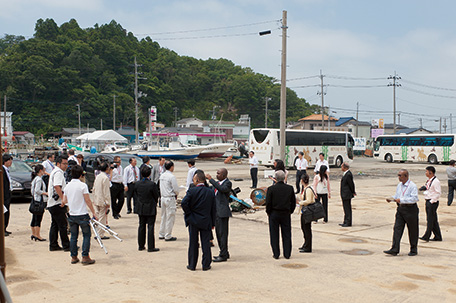Japan's Official Development Assistance White Paper 2012
Section 3 Cooperation with International Organizations for Disaster Risk Reduction and Post-Disaster Reconstruction
At the 44th UN General Assembly, Japan jointly proposed and adopted with 155 other nations a resolution designating 1990 to 1999 as the "International Decade for Natural Disaster Reduction." This resolution aims to mitigate the loss of life, property damages, and social and economic disruption caused by natural disasters through concerted international action. In 2000 following the end of the "International Decade for Natural Disaster Reduction," a subsequent "International Strategy for Disaster Reduction" was launched, based on which the UNISDR was established as an organization to promote international disaster risk reduction activities. As a country that has long asserted the importance of disaster risk reduction, Japan has assisted with funding the establishment of the UNISDR from the initial stages, and also cooperated with the release of the Global Assessment Report on Disaster Risk Reduction and activities therein. Likewise, Japan twice hosted the World Conference on Disaster Reduction for which the UNISDR serves as its secretariat, and in collaboration with the UNISDR has been central to the progress of disaster risk reduction efforts within the international community such as participating actively in drafting the international disaster risk reduction strategies of the Yokohama Strategy (1994) and its successor the HFA (2005).
Similarly, at the 2006 UN General Assembly, governments, international organizations and NGOs participated, and the "Global Platform for Disaster Risk Reduction" was established as a venue to discuss the implementation of international disaster risk reduction strategies. Japan also attends this conference positively, and has participated in the discussions. At the third assembly in May 2011, Japan presented the experiences from the Great East Japan Earthquake and the efforts for reconstruction, and pointed out that ongoing consideration is required for: the best way to divide national and local governments' roles, the combination of countermeasures for reconstruction on both the "hard" and "soft" aspects (the "hard" aspects include the construction of facilities such as dams that are useful in disaster risk reduction, and the "soft" aspects include training, education and the creation of manuals for disaster risk reduction), and for methods of passing on the lessons learned from disasters to next generations. Japan plans to use the "Global Platform for Disaster Risk Reduction" as a venue to confirm the current status of disaster risk reduction efforts in each nation, and to share valuable experiences and achievements, and furthermore, will promote the discussion of disaster risk reduction within the international community.
Likewise, Japan is strengthening disaster risk reduction efforts while also cooperating with various other international organizations. One example is the collaboration with the United Nations Development Programme (UNDP) which is taking a leading role in efforts to mainstream disaster risk reduction in developing countries. As a result of the collaboration with the UNDP, Indonesia has built a system where the government, civic societies and private corporations coordinate disaster risk reduction activities, and the first comprehensive guidelines in Southeast Asia have been formulated to assess the damages, losses and reconstruction needs due to disasters. Likewise, for many years Japan and the UNDP have shared their mutual expertise while also positively tackling recovery and reconstruction after natural disasters around the world. For example, Japan cooperated with the UNDP to assist with rebuilding the lives of victims of the Indian Ocean Tsunami, with emergency assistance to the victims of the Haiti earthquake, and with early recovery and reconstruction in areas damaged by the flooding in Pakistan.
Such collaboration with international organizations is also crucial in terms of Japan's reconstruction following the Great East Japan Earthquake and sharing those experiences with the international community. One example was the holding of workshops with experts organized by the United Nations Centre for Regional Development (UNCRD) and the United Nations Human Settlements Programme (UN-HABITAT) in the disaster affected areas (Iwate, Miyagi and Fukushima) from February to March 2012. The UNCRD visited local governments and communities in six areas within three prefectures, and arranged visits with overseas and domestic experts in addition to holding workshops. In the workshops, meetings were held between local representatives and experts, information was exchanged, and practical ideas were proposed for economic activities in the local community particularly to assist locally-based industries. Opinions were also shared on the way in which NGOs and NPOs interact during reconstruction. A total of approximately 400 representatives from the local community participated in the workshops, which were disseminated to the world by the participating experts and on the UNCRD homepage.
UN-HABITAT visited 11 cities and towns in three prefectures, and held workshops on the theme of "Emergency Workshop for the Great East Japan Earthquake." In these workshops, attendance was seen from many overseas and domestic experts who have worked on reconstruction projects after natural disasters, and many of the Tohoku local government staff participated. During the workshops, each local government in Tohoku reported on activities they implemented from immediately after the disaster, and exchanged wide-ranging opinions on issues in the achievement of future visions and policies focused on reconstruction objectives and regional development. The details were disseminated internationally. Likewise, in workshops for local corporations, UN-HABITAT reported on its experiences in reconstruction projects such as the construction of temporary housing, which it has engaged in across the world to date.

Participants in the "World Ministerial Conference on Disaster Reduction in Tohoku" visiting the Ishinomaki Port.
